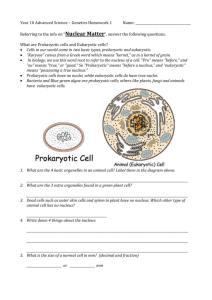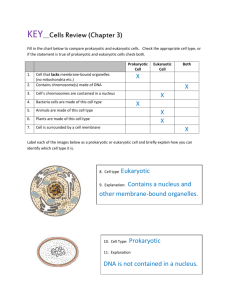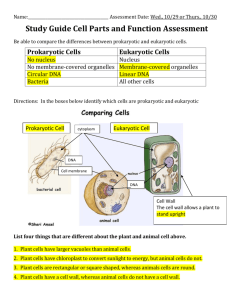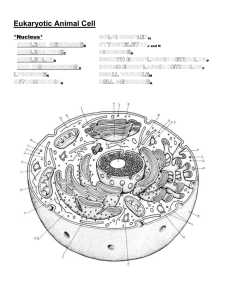plant
advertisement
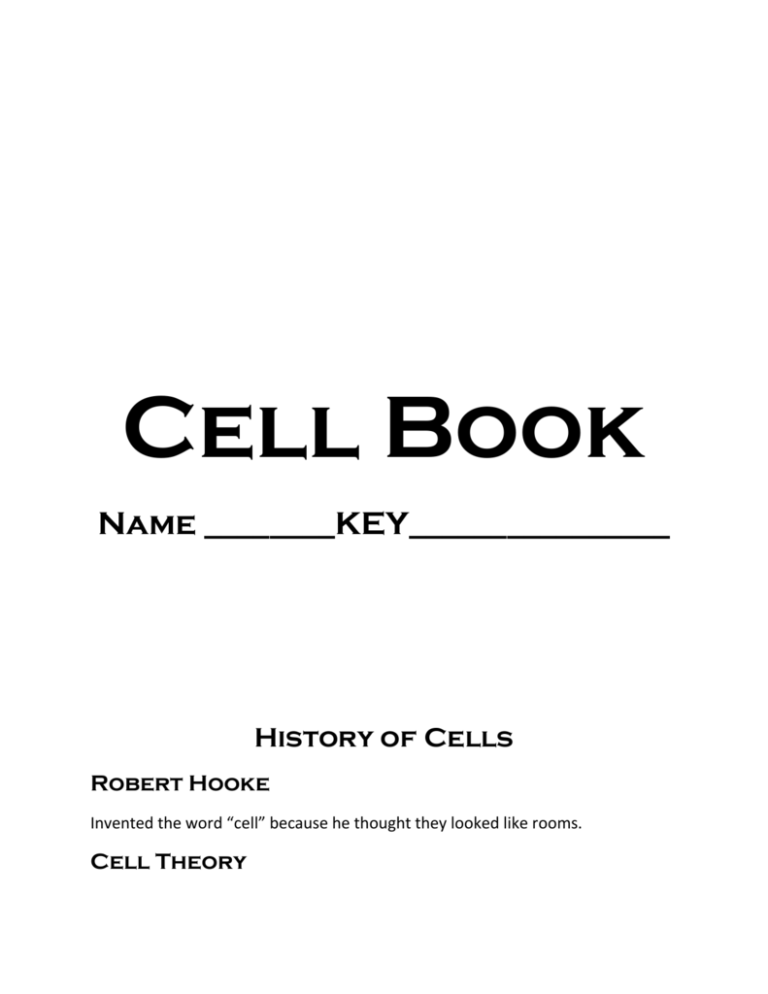
Cell Book Name ________KEY________________ History of Cells Robert Hooke Invented the word “cell” because he thought they looked like rooms. Cell Theory 1. Cells are alive. 2. All living things are made of cells. 3. All cells have to come from other cells. Levels of Organization Largest Biosphere Ecosystem Community Population Organism Organ system Tissues Cells Organelles Smallest Molecules Atom Cells Tell the difference between unicellular and multicellular and an advantage of each. Unicellular: Uni = one Definition: One celled living organism. Example: Protista, Bacteria, Amoeba Advantage: Simple, Reproduce asexually Multicellular: Multi= many Definition: a living organism made of more than one cell Example: Animals, plants, fungi Advantage: Organisms can divide work into specialized cells Lab Safety List safety considerations you took when doing the microscope lab; looking at cheek and plant cells. Wear goggles, gloves, and apron. Prokaryotic Cells 1. What is the basic definition of a prokaryotic cell? A prokaryote is a small, usually single-celled, organism that has no nucleus and no other specialized organelles. 2. What is the meaning of the word parts “pro-” and “karyo-”, and how can these word meanings help you understand what a prokaryotic cell is? Pro- means “before”, and “karyo-“ means nucleus of a cell; so, prokaryote means a cell that originated before the nucleus and has no nucleus. 3. What specialized structures, if any, are present in prokaryotic cells? Prokaryotic cells typically have a cell wall, cell membrane, cytoplasm, ribosomes, genetic material, and flagella or cilia. 4. What are examples of prokaryotic cells? Examples of prokaryotic cells include eubacteria and archaebacteria. 5. How do prokaryotic cells reproduce? Prokaryotes reproduce through binary fission. The DNA in the cell is copied, and then it grows larger and eventually splits into two cells. The two cells are genetically identical. 6. What are some ways that prokaryotic cells obtain energy? Prokaryotes can obtain energy through photosynthesis (light), chemosynthesis (inorganic chemicals), or by digesting other organisms. Prokaryotic Cells Draw and Color a prokaryotic cell and Label organelles. Highlight the organelles that are common for Eukaryotic and Prokaryotic. Eukaryotic Cells 1. What is the basic definition of a eukaryotic cell? A eukaryotic cell has a nucleus and other membrane-bound organelles like mitochondrion, chloroplasts, lysosomes, Golgi apparatus, and endoplasmic reticulum. 2. What is the meaning of the word parts “eu-” and “karyo-”, and how can these word meanings help you understand what a eukaryotic cell is? Eu- means “good, well, or true”, and “karyo-“ means nucleus or nut. This means a eukaryotic cell has a true nucleus. 3. What specialized structures, if any, are present in eukaryotic cells? Eukaryotic cells always have a membrane-bound nucleus and other membranebound organelles such as: chloroplasts, Golgi apparatus, lysosomes, mitochondrion, plastids, rough endoplasmic reticulum, smooth endoplasmic reticulum, vacuoles, and vesicles. 4. examples of eukaryotic cells? Eukaryotic cells include plant cells, animal cells, fungi, and protists. 5. How do eukaryotic cells reproduce? Eukaryotic cells reproduce through mitosis or meiosis. 6. What are some ways that eukaryotic cells obtain energy? Eukaryotic cells can obtain energy through photosynthesis or from digesting organic compounds. Eukaryotic Cells Draw and Color a Eukaryotic cell and Label organelles. Highlight the organelles that are common for Eukaryotic and Prokaryotic. Prokaryotic vs. Eukaryotic Cells. PROKARYOTIC Genetic material located in nucleoid region. Absence of membrane bound nucleus. Ribosomes (makes EUKARYOTIC Cytoplasm Genetic material located in membrane bound organelle (nucleus). Cell membrane Has membrane bound organelles. Ribosome Uses mitochondria to produce energy. DNA protein – made of RNA and protein) Mnemonic for remembering Pro vs. Eu Pro = No (no nucleus or membrane bound organelles) Eu = you (same cells as you, you have a nucleus and membrane bound organelles) Cell Pictures Bacteria Protista Animal Plant Plant vs. Animal Cells PLANT Chloroplast Central Vacuole Cell Wall ANIMAL All other organelles DNA Nucleus Cell Organelles The definition of an organelle is: _______Small organ – organ like structures within a cell_____ Cell Part Found in Prokaryotic, Eukaryotic, or Both Ribosome Both ER Eu Cytoplasm Both Structure/Function 1. The sites of protein synthesis 2. Transports materials within the cell 3. The region inside the cell except for the nucleus 4. Organelle that manages or controls all the cell functions in a eukaryotic cell 5. Contains chlorophyll, a green pigment that traps energy from sunlight and gives plants their green color. Can increase pH when plant is in water. Chloroplast 6. Digests excess or worn-out cell parts, food particles and invading viruses or bacteria Lysosome 7. Firm, protective structure that gives the cell its shape in plants, fungi, most bacteria and some protests Cell wall 8. Produces a usable form of energy for the cell Mitochondria Eu 9. Packages proteins for transport out of the cell Golgi body Eu 10. The membrane surrounding the cell; Composed of a phospholipid bilayer; controls what goes in and out of the cell Cell membrane Both 11. Small hair-like structures used for movement or sensing things Cilia / Pilli 12. Longer whip-like structures used for movement Flagella Organelle Cell Wall Plant Animal Cells Cells X Vesicle X Chromatin X Plant Cells X Eu Eu Animal Cells Mitochondria X Chloroplast Organelle Nucleus X Nucleolus X X Nucleus X X Plasma membrane X X Eu Eu Both Both Cytoplasm X X Central vacuole X Cytoskeleton X X Ribosome X X Endoplasmic reticulum X X Vacuole X X Golgi apparatus X X Lysosome X X Draw a “City” and make correlating buildings and organelles. (ex. Mitochondria = factory) Endosymbiosis Endosymbiosis Research Questions: 1. What did Kwang Jeon discover when researching Amoeba infected by bacteria? He observed that Amoeba had been attacked by a bacterial infection, and lots of the Amoeba had died. However, some survived and continued to reproduce. After investigating the remaining Amoeba and their offspring, he noticed they were very healthy. He thought maybe they were able to fight off the bacteria, but instead, he found they were still infected with the bacteria but were not dying. The bacteria were no longer making the Amoeba sick. Then, he killed off the bacteria using antibiotics and was surprised to see that the Amoeba also died. It seemed the Amoeba and bacteria had formed a relationship in which they both needed each other to survive. After researching, Jeon found that the bacteria made a protein that the Amoeba needed to survive. 2. What is endosymbiosis? Endosymbiosis occurs when one organism begins to live within another organism and both organisms benefit from this. Eventually, the two organisms evolve to become one new single organism. 3. How does the meaning of the root words “endo-“ and “-symbiosis” help you understand the meaning of endosymbiosis? “Endo-“ means within, so this helps remember that one organism lives within another organism. “-Symbiosis” means a relationship between organisms in close association with each other, so this helps remember that the two organisms have some sort of relationship and in this situation, it benefits both organisms. 4. How does endosymbiosis play a role in the evolution of prokaryotes to eukaryotes, and how are mitochondria important to this evolution? Scientists believe that long ago, two separate bacteria (prokaryotes) evolved to become eukaryotes. There were free-living bacteria that are similar to today’s mitochondrion. Another prokaryote bacteria digested or engulfed the mitochondrion-like bacteria, and instead of destroying it, it stayed within the bacteria and helped it get energy. After a long time, the two evolved into one, leading to the eukaryotic cell. 5. What is the evidence scientists have to support endosymbiosis and the evolution of prokaryotes to eukaryotes? Mitochondrion has its own membrane, just like a prokaryote has a cell membrane. Mitochondrion has its own DNA, like prokaryotes but smaller. When a cell replicates, the mitochondrion passes on its DNA, separately from the cell’s DNA that is in the nucleus. Mitochondrion reproduce by pinching in half, which is the same way that prokaryotes reproduce. Each new mitochondrion must come from another mitochondrion. If a cell were to have all its mitochondria removed, the cell could not make any more. 6. What is another cell organelle that is thought to have originated through endosymbiosis? Scientists believe that chloroplasts also underwent endosymbiosis because they have many similarities to mitochondrion (membrane, own DNA, and reproduce itself). 7. Could you find free-living mitochondrion today? Why or why not? No, mitochondrion and chloroplasts have evolved to become dependent on their host cell. They would be unable to survive without proteins made by the host cell, so they are no longer free-living. 8. What are some questions scientists still have about endosymbiosis? Scientists have still not determined how the original host and mitochondrion-like bacteria came together; was it being eaten? Was it trying to infect the cell? They are still trying to determine the species of bacteria that came together. They are working on finding answers using DNA technology. Endosymbiosis Draw and label a cell going through endosymbiosis. What will this cell become? A primitive animal cell List the evidence that supports endosymbiosis. 1. Double membranes in organelle 2. Similar methods of reproduction 3. Presence of circular DNA 4. Each mitochondria has to come from another mitochondria


